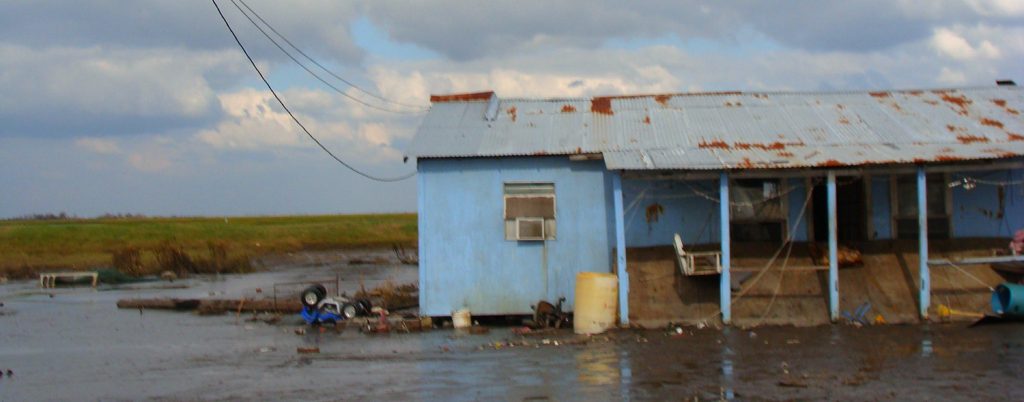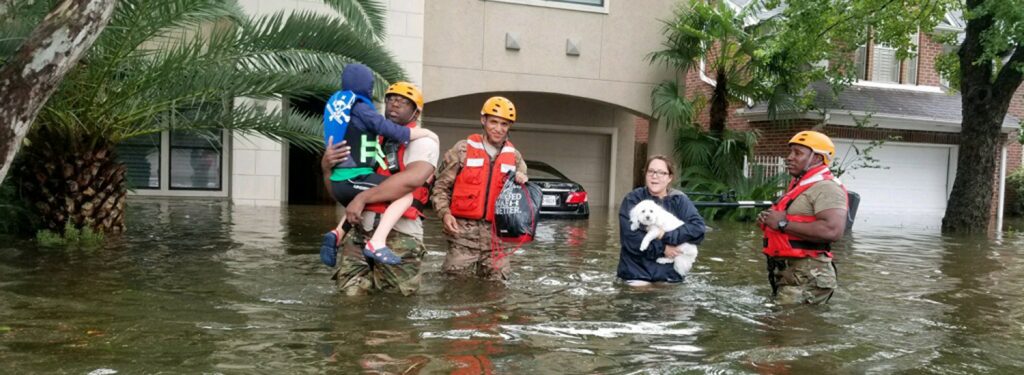Editor’s Note: This is a guest post by Christopher Galik and Gavin Smith. Galik is an associate professor of public administration at NC State whose work focuses on sustainable energy systems and policy. Smith is a professor of landscape architecture at NC State whose work focuses on natural hazards, disasters and climate change adaptation. This post is part of a series highlighting ways that NC State is helping us understand, mitigate and prepare for the impacts of climate change.
Climate change will profoundly affect how people move and where people live. Coastal communities, home to approximately 40% of the U.S. population, face the prospect of continuing sea level rise. Inland areas are not immune, faced as they are with the potential for flooding rivers and the prospect of wetter, slower-moving storms like hurricanes Harvey and Florence. Melting permafrost and increasingly intense wildfires pose challenges for communities from Alaska to Australia.
In recent years, and recent months, a pressing question is how communities forced to confront climate-induced catastrophe undertake the decision to adapt.
Protective measures may have the effect of encouraging further growth, leading to greater losses if a natural disaster (like a flood) is too much for the protective measures to handle.
This is something we’re in a good position to consider. One of us has extensive expertise in natural hazards risk reduction, disaster recovery and climate change adaptation; the other in greenhouse gas reduction opportunities from the individual to national scales. And while we both continue work in our respective fields, we also believe it is increasingly necessary to focus on the very real and impactful decisions facing communities that find themselves on the frontlines of climate change.
For example, flood-prone communities may seek to accommodate change through practices like increased structural elevation (in attempts to rise above floodwaters), while others may seek to harden against changing conditions through structures like seawalls (in attempts to block out floodwaters).
The problem with approaches like these is that they can lead to a so-called “safe development paradox,” in that protective measures may have the effect of encouraging further growth, leading to greater losses if a natural disaster (like a flood) is too much for the protective measures to handle. The failure of the levee system in New Orleans during Hurricane Katrina is a powerful case in point.
Another option is to employ land-use measures that limit development in known hazardous areas or that relocate at-risk communities following major disasters. Particularly striking are those situations where all or part of a community must contemplate a physical move. Even more striking is that these situations are not hypothetical possibilities. Community relocation poses very real and powerful present-day challenges.
Take, for example, Isle de Jean Charles, Louisiana, where 98% of the island has already been swallowed by the Gulf of Mexico. Or Newtok or Shishmaref, Alaska. Or the Florida Keys. Or Princeville, right here in North Carolina. Or any of the other 1,100 counties across the U.S. in which more than 43,000 homeowners have chosen to relocate following FEMA-funded “buyouts.”

Climate change-induced migration has been discussed in the research literature and among national and international institutions for a decade or more. Scholars are already attempting to frame the legal issues in play, and outline the complex social and policy contexts under which relocations happen. Yet, the few examples where wholesale community relocation have been attempted show that such efforts are “both burdensome and controversial,” and the absence of a comprehensive framework to guide community relocation could cause a host of problems. Community culture and identity may be lost. Infrastructure may be built without proper consideration of future needs. Resources and opportunities to relocate or rebuild may be allocated inequitably.
Development of any guiding framework for relocation will depend on input from a host of disciplines: engineering, economics, public health, communication, planning and sociology – to name a few. From where we sit, in our respective areas of expertise, there is a long list of questions to be answered and issues to be resolved.
How are decisions to relocate made? Who has a seat at the table?
Specifically, how are decisions to relocate made? Are they influenced by long-standing power imbalances at the community level? Who has a seat at the table? How are decisions made to harden infrastructure versus to relocate, particularly since the choice to do the former may complicate future efforts to do the latter. What data do communities rely on to make the decision to move? How do they initiate or oversee the process? How can cross-agency discussions and operations be better facilitated? What are the metrics that go into selecting alternative sites for a community? Are individual buy-out decisions “ad hoc,” or are they part of a broader community-wide effort to promote resilience? To what extent do buyouts actually reduce risk if communities that participate in this process continue to build in hazard-prone areas?
Once the decision has been made to move, further questions arise. What happens to the formal elements of the community, ranging from infrastructure to institutions, that are left behind? What becomes of the land? How is it repurposed? Who decides? What is the legal or financial liability associated with infrastructure left behind, and how is that managed? Are formal institutions and infrastructure simply re-created in a new location, or are they purposefully re-imagined or re-designed to address future challenges? In places where there are no open spaces for a community to move to, how do “sending” and “receiving” communities merge administration and function? What about impacts to community social capital, which is a key but often ill-defined dimension of resilience?

In reality, the process of relocation is typically characterized as a property transaction between a local unit of government and a homeowner who takes the money and moves somewhere with little assistance from government officials. When this process happens on a large scale, the loss of tax base and failure to plan for this eventuality has significant ramifications – which require a thoughtful, planned approach spanning policy, design, and engineering. Complicating matters further is the question of who will pay for it all, particularly since gradual, geophysical processes such as sea-level rise or melting permafrost are generally not eligible triggers for funding under the current disaster assistance framework administered through the federal Stafford Act.
Answering the questions above — and others that we have not even begun to think of — will require time, inter- and multidisciplinary expertise, and close cooperation with affected communities. Such work has occurred in the past at NC State, and more is underway.
For example, a new certificate program in Disaster Resilient Policy, Engineering and Design is bringing faculty together and training students to tackle tough interdisciplinary problems like these. We are separately exploring how buyouts have been used in countries such as Australia, New Zealand, and here in the U.S., as well as how efforts to simultaneously reduce greenhouse gases and vulnerability to climate-induced disasters may be better integrated in both natural and built environments. But more work is required. And the time for that work is now.
This post was originally published in NC State News.
- Categories:



